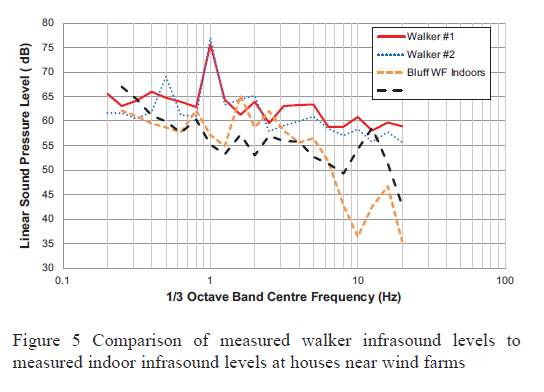Is walking down the street a major health risk?
It seems like an odd question, but it’s relevant to the issue of wind farms and human health – something that has, surprisingly, come up in the media in recent weeks.
In our experience dealing with communities near our operational wind farms, we’ve found that the overwhelming majority of people that live near turbines are very happy with their presence.
The Australian Wind Alliance went to the effort of creating a series of videos in which they talk to residents living near the Waubra Wind Farm in Victoria. You can see the videos here, or have a look at the embedded one below.
It’s important to look at the science alongside the real experience of individuals and communities. In that vein, we’d like to briefly summarise three recent pieces of research that have come out in recent months that relate to the issue of health around wind farms.

An open day at the Hepburn community wind farm Walking infrasound vs wind farm infrasound – source: renew economy
Walking Infrasound VS Wind Farm Infrasound
A group of acoustics researchers published a study comparing the infrasound we’re exposed to when we simply walk around to the infrasound we’re exposed to when we’re near a wind farm. They write in their abstract:
“Measurements have been conducted of the levels of infrasound generated at the human ear when walking and compared to measured levels near wind farms. The measured level of infrasound generated at the ear at blade pass frequency when people walk can be considerably higher than the level near wind farms. In both cases, measured levels were significantly below the audibility threshold for very low frequency noise.”

Infrasound is ubiquitous in our environment – it’s extremely unlikely that, at low levels, we would be responsive to it.
Health Canada
Late last year, Health Canada, the government body tasked with protecting the health of the country’s citizens, announced the results of a two year study. It involved 1,238 homes, 4,000 hours of acoustic data, 17 different models of wind turbine, two provinces and came at a total cost of $2.1 million AUD. The expert committee included two dozen government, academic and industry experts, and four international advisors.
After taking measurements from residents living near wind farms, they found no link between the operation of wind turbines and dizziness, migraines, heart disease, blood pressure, diabetes, heart rate, cortisol levels or measured quality of sleep. There were some increases in ‘annoyance’ levels as sound levels, visibility of turbines, or visibility of aircraft warning lights increased.
23rd Evidence Review
The 23rd review of the current body of scientific evidence around wind farms and low-frequency noise emissions, was released recently, and it was published by the following scientists:
“Robert J. McCunney, MD, MPH, Kenneth A. Mundt, PhD, W. David Colby, MD, Robert Dobie, MD, Kenneth Kaliski, BE, PE, and Mark Blais, PsyD”
Their results are relatively simple:
“(1) Infrasound sound near wind turbines does not exceed audibility thresholds.
(2) Epidemiological studies have shown associations between living near wind turbines and annoyance.
(3) Infrasound and low-frequency sound do not present unique health risks.
(4) Annoyance seems more strongly related to individual characteristics than noise from turbines.”